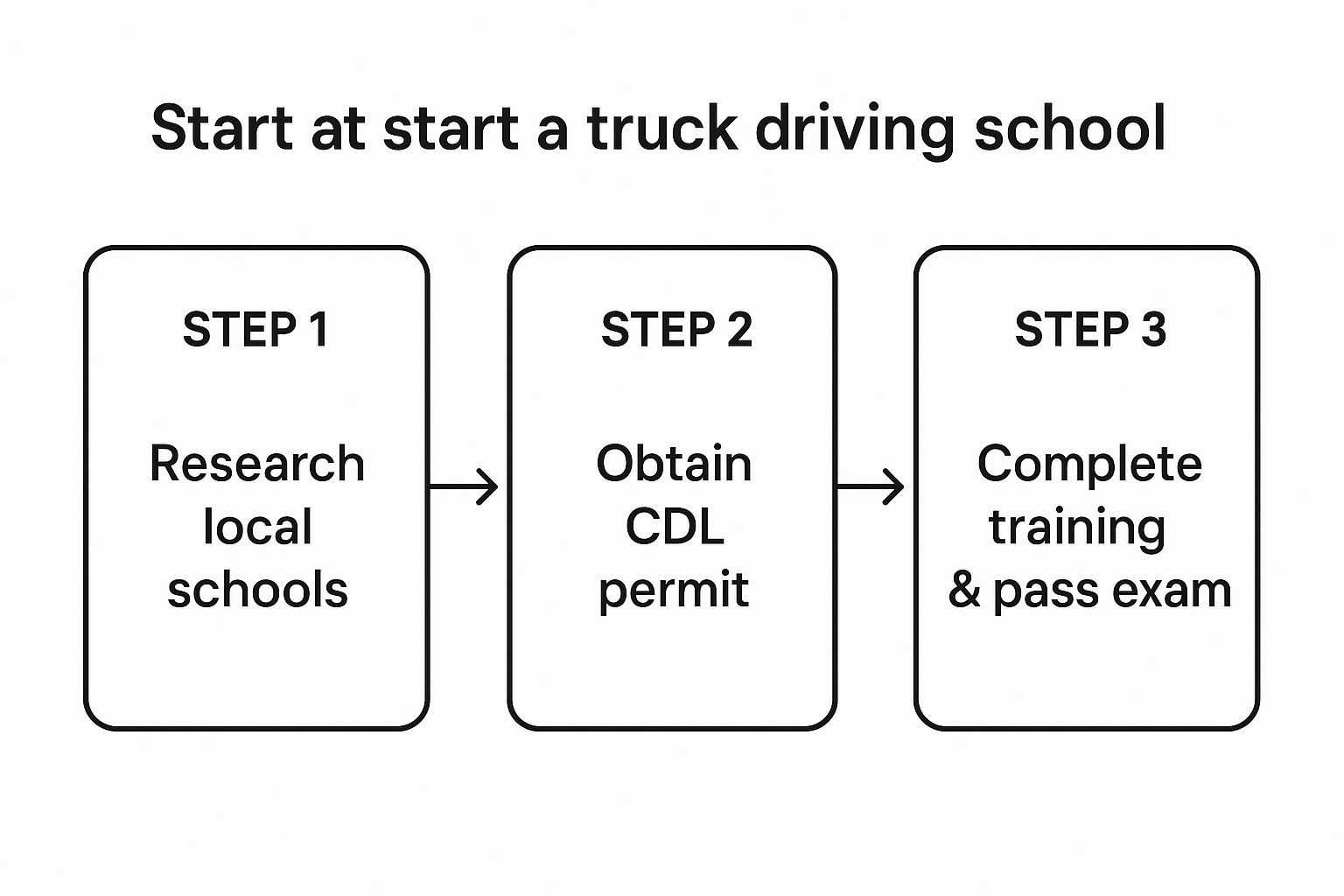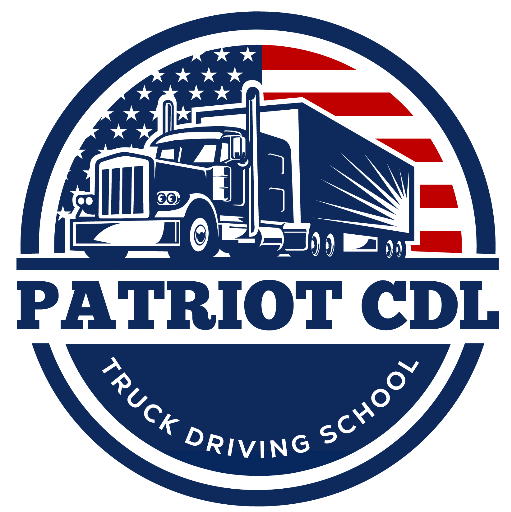You've just typed "truck driving school near me" into a search bar. That simple act is the first step toward a completely new career, one with a lot of freedom and responsibility. To make that search really count, you need a game plan. It's time to figure out exactly what you need from a program before you even start comparing schools.
How To Start Your Search For a Local Truck Driving School
Kicking off your search can feel like a huge task, but it really comes down to three key things: the license you're after, your budget, and your personal schedule. Getting these figured out from the jump will immediately clear out the options that won't work for you. It saves you a ton of time and lets you zero in on the schools that can actually help you hit your goals. Honestly, this upfront homework is the most important part of the whole process.
This visual gives you a good roadmap of the journey from where you are now to getting that license in hand.

As you can see, getting your CDL permit is a non-negotiable step right in the middle of it all, bridging the gap between picking a school and starting your hands-on driver training.
Define Your Career and Training Goals
First things first: what kind of truck do you want to drive? This determines which Commercial Driver's License (CDL) you need.
- A Class A CDL is the big one. It's the most versatile license, letting you operate massive tractor-trailers and other combination vehicles. This is your ticket to long-haul, over-the-road, and regional jobs.
- A Class B CDL is for single vehicles like dump trucks, straight trucks, or buses. This license usually leads to local jobs where you're home every night.
Once you know which license you need, your search for a "truck driving school near me" gets a lot more focused. You can instantly filter for programs that offer the right certification.
Next, be realistic about your timeline. Can you go all-in on a full-time, accelerated program and be ready to test in a few weeks? Or do you need a more flexible part-time or weekend schedule to juggle training with your current job and family life?
A clear vision for your career—whether that’s crossing the country or making local deliveries—is the bedrock of your school search. It dictates the license you pursue, the training you need, and the jobs you’ll be qualified for.
The demand for good drivers has caused the training industry to grow significantly. The global driving school market was recently valued at around $98.71 billion and is expected to keep climbing, which just shows how much need there is for skilled, professional drivers.
To help you get started, here's a quick rundown of the main factors to consider when you begin your search.
Quick Comparison of Local Truck School Factors
| Factor to Consider | What to Look For | Why It Matters |
|---|---|---|
| CDL Class Offered | Does the school offer training for Class A, Class B, or both? | Your career goals (long-haul vs. local) directly depend on getting the right class of license. |
| Program Schedule | Are there full-time, part-time, weekend, or evening options available? | The schedule must fit your life. A program you can't attend consistently is a waste of money. |
| Cost & Financing | What is the total tuition? Do they offer payment plans, grants, or veteran benefits? | Understanding the full cost and your payment options prevents financial surprises and stress. |
Thinking through these three points before you make any calls will make your entire search smoother and more effective.
Prepare for the Initial Requirements
Before you can even think about climbing into a truck, you have to get your Commercial Learner's Permit (CLP). This is a written knowledge test that covers all the essentials: traffic laws, basic vehicle operations, and critical safety rules.
Think of the CLP as your entry ticket. Passing this test is the first real hurdle, and you'll want to be prepared. You can learn more about how to get your CDL permit to get a head start on the material. Just about every reputable school will require you to have your CLP in hand before they let you get behind the wheel for training.
Digging into School Accreditation and Program Quality

Alright, you've got a short list of potential schools. Now comes the most important part: vetting them to make sure you're getting quality training and not just a piece of paper. This is where you separate the real-deal programs from the diploma mills.
Your future confidence on the road, your safety, and your job prospects all hinge on the quality of your training. Don't rush this.
The absolute first thing you need to check is if the school is licensed by the state. This is the bare minimum. If a school isn't officially licensed to operate, walk away. It’s a non-negotiable sign of a legitimate program that meets basic standards.
Confirming Key Program Credentials
State licensing is just the starting line. A few other credentials really matter. The big one is compliance with the Federal Motor Carrier Safety Administration’s (FMCSA) Entry-Level Driver Training (ELDT) rules. Since 2022, every new driver has to complete this federally required training before they can even attempt their CDL skills test.
Another huge plus is finding a school that's also a certified third-party examiner. This is a game-changer. It means they're authorized to administer the official CDL skills test right there on their own property, using the very same trucks you’ve been training in. That familiarity can take a lot of the pressure off on test day.
The trucking boom has led to more schools popping up everywhere. In fact, the number of truck driving schools in the US grew by an average of 1.0% per year between 2018 and 2023. More options mean you have to be even more careful in your selection.
What to Ask About the Actual Training
The curriculum is what you're really paying for. Don't hesitate to get specific and ask some tough questions about their hands-on instruction.
- What’s the student-to-instructor ratio? You want as much one-on-one time as possible. A low ratio, especially for behind-the-wheel time (aim for 4:1 or better), ensures you get personalized feedback.
- How many hours are actually spent driving? Classroom time is essential, but nothing replaces real-world experience. Look for programs that guarantee at least 40-50 hours of actual drive time on the road.
- What specific skills do you teach? A good curriculum goes way beyond just driving in a straight line. It should cover everything from shifting and basic backing to advanced maneuvers like alley docking, parallel parking, and dealing with tight city streets.
A school that’s proud of its training will be happy to give you detailed, straight answers. If you get vague responses like "we provide plenty of drive time," consider that a major red flag.
Finally, be wary of any school using high-pressure sales tactics or making pie-in-the-sky promises about "guaranteed jobs." A reputable school focuses on delivering top-notch training, because they know that’s what gets their graduates hired by the best carriers. To learn more about the specific benchmarks you'll need to meet, check out our detailed breakdown of CDL requirements.
What's the Real Price Tag on CDL Training?

When you start looking up local truck driving schools, you'll see tuition prices advertised everywhere. Here’s a piece of advice from someone who's been there: that sticker price is almost never the full story. To get a real handle on what you'll actually spend, you have to dig a bit deeper.
Building a realistic budget from the get-go means looking past that big tuition number and factoring in all the smaller, but necessary, costs. It’s the difference between a smooth start and an unexpected financial headache.
Don't Forget the "Other" Fees
Before you ever sit in a truck, you’ll have a few expenses to take care of. Think of these as the prerequisites for getting your training started. Most schools expect you to cover these costs separately from your main tuition bill.
You'll want to budget for things like:
- DOT Physical & Drug Test: These are non-negotiable. Every commercial driver has to pass these federal medical exams to prove they're fit for the road.
- Commercial Learner’s Permit (CLP): This is your ticket to start behind-the-wheel training. You’ll pay a fee directly to your state’s DMV for the written tests and the permit itself.
- CDL Licensing Fees: Once you ace your skills test (the driving part), you'll head back to the DMV to pay another state fee for your official Commercial Driver's License.
- School Enrollment Fees: Some schools have a one-time administrative fee for processing your application and getting you set up in their system.
Individually, they might not seem like much, but these costs can easily add up to several hundred dollars. Always ask for a detailed fee schedule upfront so there are no surprises.
How to Pay for Your CDL Education
Feeling a little sticker shock? Don't worry. Very few people pay for everything out of pocket. There are some fantastic options available to help fund your new career, each with its own set of pros and cons.
Key Takeaway: The way you pay for school is just as important as the training you receive. The right funding plan lets you focus on learning, not on financial stress.
Figuring out the best path forward involves weighing your options, from grants to company commitments.
Comparing CDL School Funding Options
Let's break down the most common ways to cover your costs. Each has a different balance between what you pay now and what you commit to later.
| Funding Option | How It Works | Key Commitment/Pro | Potential Con |
|---|---|---|---|
| Company-Sponsored Training | A carrier pays your tuition. | Usually no upfront cost. | You must sign a contract to drive for them for a set time (often 1 year). |
| WIOA Grants | Federal grant for displaced or low-income workers. | It's a grant, not a loan—you don't pay it back. | Requires meeting eligibility criteria and can have a lengthy application process. |
| GI Bill® | VA benefits for eligible veterans and service members. | Your military service helps pay for your new career. | You must have GI Bill® eligibility and find a VA-approved school. |
| In-House Financing | The school offers a payment plan. | Spreads the cost out over time, making it more manageable. | May have higher interest rates than a traditional loan. |
The right choice really depends on your personal financial situation and career goals. If you're eager to get to work and have a company in mind, sponsored training is an amazing deal. If you qualify for a grant like WIOA, you can start your career with zero debt. Take the time to explore every avenue.
What's Their Track Record for Getting Graduates Hired?
Let's be honest, the whole point of going to truck driving school is to land a great job. This is where the rubber really meets the road in your school evaluation. You need to look past the curriculum and tuition costs and dig into how well they actually connect their students with careers.
A school's job placement support says everything about its reputation in the industry and the real-world success of its graduates.
Be wary of any school that throws around a "guaranteed job" promise. That’s usually just a marketing gimmick. What you're really looking for is genuine job placement assistance. This means the school has built solid, long-standing relationships with a variety of reputable carriers. They act as the middleman, bridging the gap between their newly-minted drivers and companies that are eager to hire them. A strong network is a huge sign of trust.
Digging Deeper on Career Services
When you're talking to an admissions advisor, don't let them off the hook with vague answers about their career services. It's your future on the line, so get specific.
- What's your actual placement rate? Don't just accept a general "high" or "good." Ask for a hard number, like the percentage of graduates from the last six months who got jobs through their assistance.
- Which specific companies recruit here? They should be able to rattle off a list of local, regional, and even national carriers that actively hire their students.
- Is placement assistance a one-and-done deal, or is it for life? Lifetime placement assistance is a massive perk. A school that's willing to help you find a job years down the road, not just right after graduation, is providing incredible long-term value.
A school’s job placement success is the ultimate proof in the pudding. If top-tier carriers are consistently hiring their graduates, you know their training program is doing something right.
The good news is that the industry is hungry for qualified drivers, which puts you in a great position. The U.S. Bureau of Labor Statistics pegs the median annual pay for heavy and tractor-trailer truck drivers at over $55,000, and that’s just the median—there are plenty of opportunities to earn much more.
At the end of the day, the quality of your training directly influences your starting pay and career trajectory. A school with strong industry connections can open doors you'd have a much harder time opening yourself. It's also a smart move to see how their CDL training program specifically prepares you for the kinds of jobs their partner companies are offering. Your investment in school should absolutely pay off with a real-world career.
What to Look for During an On-Site School Visit
A school’s website and glossy brochures are built to sell you a dream. An in-person visit is where you separate the slick marketing from the cold, hard reality. Think of it as your chance to play detective and see if the school actually lives up to its own hype.
When you first step onto the campus, just take a moment to soak it all in. What's your gut feeling? Does the place feel professional and organized, or is it chaotic and a bit run-down? First impressions really do matter here—they often tell you a lot about the quality of the training you can expect.
Inspecting the Training Equipment
The first thing to check out is their fleet of trucks. You don't need to be a diesel mechanic to spot obvious red flags. Are the trucks reasonably modern and clean, or are they rusted-out relics from a bygone era? Equipment that's well-maintained is a clear sign that a school invests in its students' safety and success.
Next, take a good long walk around the practice yard. A tiny, cramped lot is a huge problem. You absolutely need enough space to practice the fundamentals—backing, turning, docking—without feeling like you're in a demolition derby. A spacious, well-paved yard is non-negotiable for building the skills you'll use every single day on the job.
The condition of the trucks and the layout of the practice yard are direct indicators of the school's commitment to providing high-quality, professional training. Don't overlook these physical clues.
Questions for Instructors and Students
Now for the best part: getting the unfiltered truth. Find an instructor and ask them about their own time on the road. The best teachers aren't just reading from a book; they've got years of real-world trucking experience to share.
Then, try to catch a few current students when they're on a break and away from any staff. This is where you'll get the real scoop.
Ask them direct questions, like:
- "So, how much actual driving time are you getting each day?"
- "Are the instructors patient? Do they give you good feedback?"
- "What's one thing you wish you knew before you signed up here?"
The answers you get from students are pure gold—they're often the most honest and insightful feedback you'll find. A huge part of your hands-on training will be learning your truck inside and out, starting with a detailed vehicle check. You can get a head start by reviewing a complete guide to the CDL pre-trip inspection. Mastering this skill is critical, both for passing your test and for staying safe throughout your career.
Answering Your Top Questions About CDL Schools

As you get closer to picking a school, you're bound to have some lingering questions. That's perfectly normal. Getting straight answers to these common queries will help you feel confident in your final choice and ready to hit the ground running.
One of the biggest questions I hear is, "How long will this actually take?" For a full-time Class A CDL program, you can expect to be in training for three to seven weeks. The exact duration really hinges on your state's specific requirements and how the school structures its curriculum.
Need something that works around your current job? Many schools offer part-time or weekend classes, which are great for flexibility. Just keep in mind that this route will naturally stretch your training out over a few months instead of a few weeks.
What Are the Basic Entry Requirements?
Before you can even think about getting behind the wheel, you have to meet a few core requirements. Don't worry, they're pretty straightforward.
To enroll, you’ll generally need to be:
- At least 18 years old to drive commercially within your own state (intrastate).
- At least 21 years old to drive across state lines (interstate).
You'll also need a valid driver's license with a good driving record. Every potential student must also pass a Department of Transportation (DOT) physical exam and a drug screening before classes begin.
So, what happens if you don't pass the CDL exam on your first attempt? It's a common concern. A good school will have a clear re-testing policy. They should provide extra practice to get you over the hump and let you retake the test, but you absolutely need to ask if they charge extra fees for it.
Finally, you'll see ads for company-sponsored training, which sounds amazing with no upfront tuition costs. The catch? You have to sign a contract, committing to drive exclusively for that company for one to two years. It can be a great option if you're already sold on that carrier, but it does lock you in and reduces your career flexibility right out of the gate.
A great way to get a head start is to begin studying for your permit now. You can learn more about what's on the CDL general knowledge test and get prepared.
